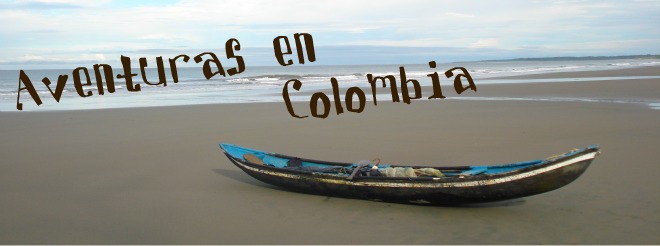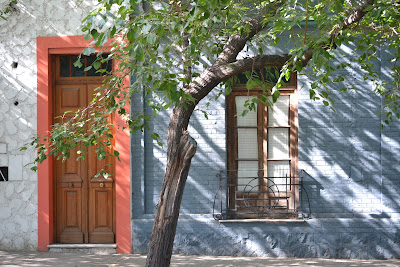Part VI of VI
How predictable to title the final Argentina post on the beautiful capital city with a lyric from
"Evita," right? Sorry to say, but it works. Everything seems new in Buenos Aires. A mere ten years after major riots rocked this metropolis following the country's serious economic collapse, the city has lifted itself up, regained its footing, and begun anew.
Every barrio of this historic city carries its own unique history, flavor, and life unto itself. In the week we stayed here, we spent about a day in each neighborhood, seeing the sites, taking in the atmosphere, and taking advantage of each and every coffee shop we could find.
San Telmo
 |
La Casa Mínima
(The Narrowest House) |
One of the oldest of Buenos Aires' barrios, this is where the rich lived until the early 1870's when an epidemic of Yellow Fever hit, causing a mass exodus of the area, allowing for mostly Italian immigrants to move in, thus turning many of the large aristocratic homes into tenement buildings. Many of these structures still remain today - including the house we rented - thus making this neighborhood popular with tourists and hostels alike.
Other than strolling the cobblestone streets and popping in and out of used bookstores, antique shops, and gelato counters, San Telmo is famous for its weekly San Pedro Telmo street fair. Beginning in the tiny Plaza Dorrego and running all the way up historic Defensa Street to Plaza de Mayo in the neighborhood of Microcentro, the fair boasts an unending supply of antiques and art. Need a new turn of the century seltzer bottle? You've come to right place!



My favorite San Telmo find was the inconspicuous San Telmo Market. Despite taking up nearly an entire city block, Kristin and I literally almost could not find it the second time we went looking for it. Inside vendors have set up fruit stalls, spice booths, and specialty antique and collectible "stores." Having had a good portion of my pre-school years being raised in the narrow passageways and stairwells of the old mill buildings in downtown Stillwater, Minnesota, as my mother perused the selection of antique furniture for the next bookshelf or dresser to refinish, I felt strangely at home!
(I successfully unearthed a handsome two-part map of South America from the 1930's that I plan to have framed as well as a lithograph of unknown date cleanly torn from a book depicting Amazonian tribesmen catching a large snake with the label "Colombia" on it.)
Since this is a bit of a student/backpacker/artist part of town, it is impossible to deny the bohemian vibe. In fact, you'd have to be blind since the graffiti and street art is bright, creative, and everywhere. In fact, I've never seen a neighborhood so wholly embrace it and not be littered with crack needles and passed out bums. We considered setting up a "graffiti tour" business; I'm sure there's a client base for that!
La Boca
Located a short walk from San Telmo in the adjacent barrio to the south, La Boca is the most dodgey of the tourist neighborhoods. Really, there are only two reasons to end up here. The first is to see the uber-touristy El Caminito - a wildly colored pedestrian street that now screams "tourist trap" at the top of its patchworked lungs - and the CABJ (Boca Juniors) Stadium. The later was closed as the team is between seasons.
That's it. Tour of La Boca, finished.
Next...
 Microcentro
Microcentro
Microcentro is home to both the downtown commercial district and the stately Plaza de Mayo, the first official large plaza in Buenos Aires. On the eastern edge of this Plaza lies the Casa Rosada, Argentina's version of the White House (although the President actually lives elsewhere). The central balcony is the location of the famous "Don't Cry For Me, Argentina" scene. There is also a nice (air conditioned) museum located underneath the Casa Rosada devoted to the presidential history of Argentina as a republic.
Puerto Madero
This neighborhood actually didn't exist when Buenos Aires was first founded - something we learned while visiting the aforementioned Casa Rosada Museum. This long stretch of land spanning the distance of Microcentro and San Telmo is filled with many new and ritzy apartment high-rises, fancy hotels, and a large park that borders the sea. Puerto Madero is also home to another of Buenos Aires' most famous symbolic landmarks, the Puente de Mujer, a pedestrian bridge spanning the barrio's canal, supposedly representing a female tango dancer.
Congreso
Buenos Aires' barrio for architecture buffs does not disappoint. Mixing styles as diverse as belle epoque and Spanish neo-colonial (you better believe I looked that up!), Congreso is home to some of the capital city's most important and impressive buildings, including its namesake, the Palacio del Congreso (House of Congress), and the Palacio de Justicia (Supreme Court Building).
 |
Rodin's The Thinker in front of the Palacio del Congreso
(A quick Wikipedia search reveals he made several.) |
Another interesting architectural edifice was that of the Palacio de las Aguas Corrientes, the home of the city's privatized water works facilities. Toeing the line between gaudy and extravagant, the façade is a risky combination of colorful-yet-muted terracotta tiles, a castle-like fortitude, and a quasi-French flair, the building, opened in 1894, stands out from its mostly concrete neighbors like a beautifully bruised thumb nail.

The day we visited Congreso was the day we had set aside time to tour the recently reopened Teatro Colón. The tour was little more pricey than we had anticipated but well worth it. Built in 1908 - the theatre company was originally located in a building, now the National Bank, next to Microcentro's Casa Rosada - it is one of the most renowned opera houses in the world. Luciano Pavarotti was known to have complimented the acoustics saying that the only flaw was that the theatre was "too perfect" and the audience can hear your slightest mistake. Indeed, our guide informed us that the acoustics change depending on the number of people in the audience and what they are wearing. Just walking through the foyer you could see the work the three different architects put into it during its construction, creating a work of art that rivals any of the masterpieces performed on its massive stage.
Palermo
The largest and most residential of Buenos Aires' downtown barrios, Palermo itself has been divided into smaller sections - Palermo Chico, Palermo SoHo, Palermo Viejo, and Palermo Hollywood to name a few. Once known for its collections of hip shops selling clothing, accessories, and jewelry by undiscovered slash up-and-coming designers, Palermo SoHo in particular, seems to be be quickly going the way of many trendy areas that get found by the masses. Noted for evidence: When there is a Diesel store on the corner, you're officially past your bohemian-arsty tipping point.
Some of the other more popular reasons to visit Palermo are the abundant and immaculate parks (which we did not see) and the Museo de Arte Latinoamericano de Buenos Aires (which we did). MALBA is a small but renowned museum exhibiting one floor of works by famous Latin American artists; the museum has works by Colombian Francisco Botero and Mexicans Frida Kahlo and Diego Rivera, among others. There was also a phenomenal exhibit featuring the life works of Venezuelan Carlos Cruz-Díez.
Recoleta
The neighborhood where the rich residents of San Telmo evacuated to after the aforementioned Yellow Fever epidemic still holds its upper-class shine well. Filled with beautiful mansions, a nice oceanside drive, many small parks and walking paths, the barrio is a great place to pass the day.
We started our self-guided tour with a stop to see the famous Floralis Genérica, an enormous statue of a flower that physically opens and closes at the beginning and end of each day. A short walk across the street was another art museum, the Museo National de Belles Artes, which, compared to MALBA, featured a much more comprehensive and worldly collection of pieces by the likes of Monet, Degas, Toulouse-Lautrec, and Rodin, as well as some famous Argentine painters such as Cándido López and Prilidiano Pueyrredón.

One of Recoleta's most popular attractions, however, is the Recoleta Cemetery. This above-ground "city of the dead" seems like a morbid tourist stop, however, the graves and mausoleums are works of art unto themselves, some the size of small houses. While many notable Argentines are buried here, including many famous artists and ex-Presidents, the largest draw is the modest tomb holding the body of Eva Perón. You would be hard-pressed to find a visitor who did not stoop down to take a picture of the small, ground-level plaque which declares her name.
Of all the places we visited in Argentina, it is a safe bet that I took more pictures during the brief time we were in the cemetery, than at any other single location throughout the trip; everywhere you turned was a new angle, shadow, statue, juxtaposition, or irony to capture on film.
Buenos Aires won me over easily. This is truly one of the world's great cities. Historic and modern, stylish and revered, classic and gritty, Buenos Aires wears it all well and with pride.
 |
| The entire Argentina crew after the El Querandí tango show. |



















































